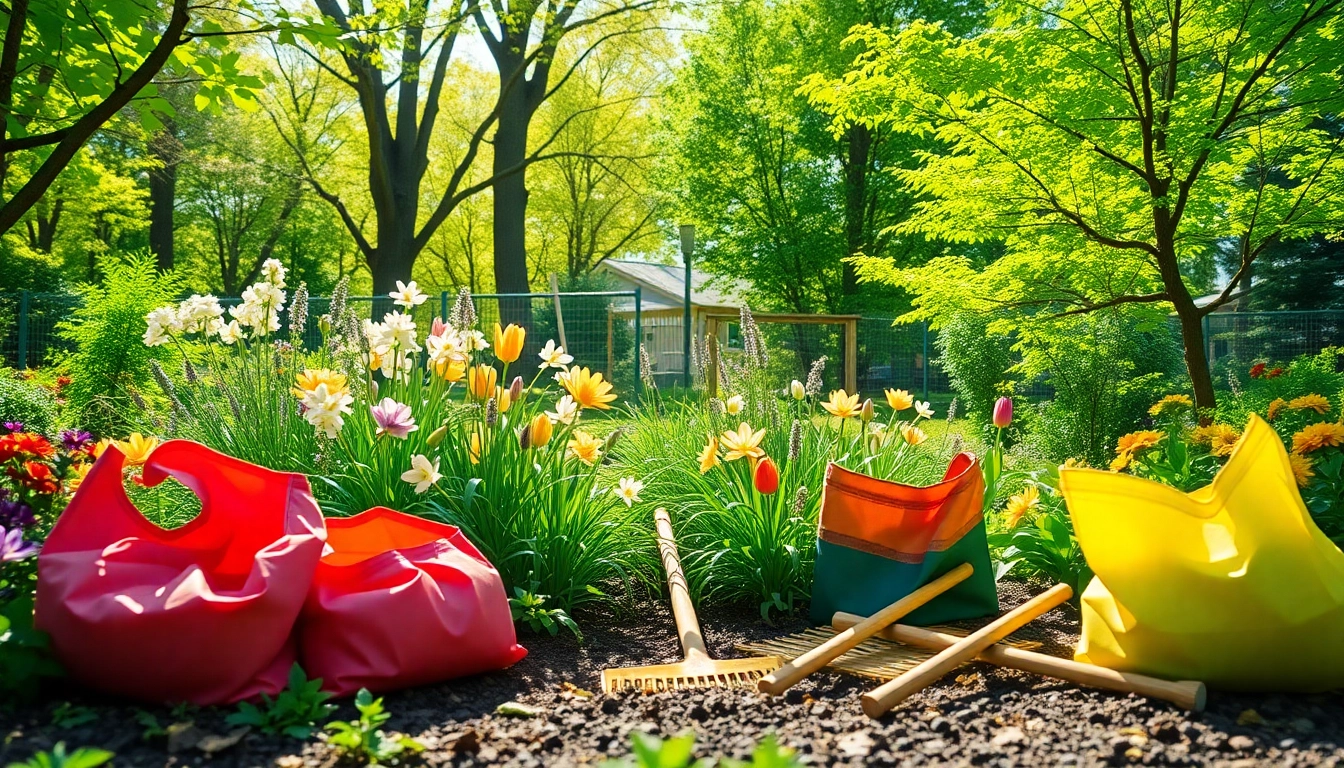Understanding the Importance of Spring Clean Up
As the chill of winter recedes and the days grow warmer, homeowners often turn their attention to rejuvenating their outdoor spaces. One of the most crucial tasks in garden maintenance is the spring clean up. This process not only prepares your lawn and garden for the vibrant season ahead but also sets the stage for healthy growth throughout the year. Understanding the significance and intricacies of spring clean up will help you harness the natural beauty of your yard while promoting the health of your plants.
Why Spring Clean Up Matters for Your Lawn
Spring clean up serves multiple purposes, crucial for the overall health and aesthetics of your lawn and garden. Firstly, it aids in the removal of debris that has accumulated over the winter. This includes fallen branches, dead leaves, and garden refuse that can suffocate new growth. Secondly, spring clean up helps in identifying any potential pest issues or diseases that could threaten the health of your plants. By tackling them early, you can ensure a thriving garden as the season progresses. Moreover, a well-maintained yard enhances curb appeal, ultimately increasing property value.
The Seasonal Transition: Timing Your Cleanup
Timing is key when it comes to spring clean up. Typically, the best time to begin is when daytime temperatures consistently exceed 50°F (10°C) for several days, which is an important threshold for many perennial plants to begin their active growth phase. It’s advisable to conduct your spring clean up early in spring, usually between March and April, depending on your geographical region. This allows your lawn to breathe, ensuring that soil, sunlight, and nutrients can reach your plants effectively.
Benefits of a Well-Maintained Yard
A well-kept yard offers numerous benefits, such as creating a pleasant environment for gatherings, enhancing mental wellness through nature connection, and promoting local wildlife. Furthermore, a tidy garden can prevent weed proliferation, conserve water more effectively, and increase soil health through improved aeration and moisture retention. Each of these advantages contributes to a self-sustaining ecosystem that minimizes reliance on chemical fertilizers and pesticides.
Key Tasks in Your Spring Clean Up Checklist
Knowing which tasks to include in your spring clean up can make the process smoother and more effective. Here’s a comprehensive checklist to guide you through the essential steps:
Essential Tools for Effective Yard Cleanup
Before diving into your spring clean up, equip yourself with the right tools. A sharp rake, pruners, a shovel, garden gloves, a leaf blower, and a composter will make the tasks easier and more efficient. You might also consider investing in a high-quality bagging mower, which can collect clippings as you mow, reducing the need for additional clean up later. Having these tools ready will speed up the process and make it far more enjoyable.
Step-by-Step Guide to Debris Removal
- Assess the Area: Conduct a walk-around of your yard to look for debris. Make note of areas that need more attention.
- Start with Bigger Debris: Remove larger items such as branches or rocks first. This will help you see the smaller debris more easily.
- Clear Leaves and Smaller Debris: Use a rake or leaf blower to gather leaves and smaller debris, placing them in compost or designated yard waste bags.
- Check for Object Hazards: Look for sharp objects like rocks or broken glass hidden in the grass that can pose injury risks.
- Mulch: Consider mulching your flower and garden beds with organic matter to retain moisture and suppress weeds.
Pruning Techniques to Promote Growth
Pruning is a crucial step in your spring clean up, as it encourages healthier and more vigorous growth. Here are some expert tips on how to prune effectively:
- Timing: Prune during the dormant season or just as plants begin to wake from dormancy; this varies with plant types.
- Remove Dead or Diseased Branches: Cut away any branches that appear dead or diseased to prevent the spread of illness.
- Shape and Size: Trim back foliage to maintain an attractive shape and size. Focus on branches that cross or rub against one another.
- Use Proper Tools: Ensure your pruning shears are sharp and clean to make precise cuts, minimizing stress to the plant.
Cost Considerations for Spring Cleanup Services
Understanding the costs associated with spring clean up can help you budget effectively, whether you choose to do it yourself or hire professionals. Pricing can vary significantly based on regions, the size of your property, and the scope of work required.
Average Costs by Region
On average, homeowners can expect to pay between $250 and $600 for professional spring clean up services, depending on their location. For instance, in California, costs might average around $520, while states like Georgia may see averages down to $330. These regional variations reflect differences in labor and material costs that potential clients should consider.
DIY vs. Hiring Professionals
When weighing DIY options against hiring professionals, consider the following:
- Cost Savings: DIY can save you money, especially if you own the necessary tools and have the time.
- Expertise: Professionals bring experience that may save you time and help avoid mistakes that could lead to additional costs.
- Labor Intensity: Some spring clean up tasks can be physically intensive, and homeowners may opt to hire help for larger jobs.
What to Expect in Service Pricing
If you decide to hire a service, expect to receive a detailed estimate outlining what is included. Prices may vary based on:
- Size of Yard: Larger properties demand more labor and materials.
- Type of Services: Comprehensive plans that include treatment for weeds or pests may come at a premium.
- Frequency of Service: Regular maintenance contracts often come at a discounted rate compared to one-time clean ups.
Seasonal Plant Care Following Cleanup
After tackling your spring clean up tasks, the next step involves ensuring your plants are cared for properly as they transition into the growing season. Here are some best practices for plant care:
Fertilization Best Practices Post-Cleanup
Once your yard is clean, applying fertilizer can give your plants the essential nutrients they need to thrive. Here are some guidelines:
- Choose the Right Fertilizer: Opt for an organic or slow-release fertilizer that matches the needs of your grass and garden plants.
- Timing: Apply fertilizer shortly after cleaning to ensure your plants have access to nutrients as they begin to grow.
- Follow Instructions: Always adhere to the instructions on the fertilizer package to prevent over-fertilization.
Watering Techniques for New Growth
Hydration is critical following spring clean up, especially as plants begin to actively grow. Here’s how to establish a good watering regime:
- Soil Testing: Before watering, check if the soil is dry a couple of inches down.
- Deep Watering: Instead of frequent shallow watering, focus on deeper watering less often to encourage roots to grow downwards.
- Consider Drip Irrigation: If feasible, installing drip irrigation can ensure consistent moisture levels.
Identifying Pests During Spring
As spring arrives, so do various pests. Being proactive about pest management is vital for the health of your garden. Here are some strategies:
- Regular Inspections: Routinely check plants for signs of infestations such as holes in leaves or sticky residue.
- Natural Solutions: Consider insecticidal soaps, neem oil, or introducing beneficial insects to manage pest populations without harsh chemicals.
- Maintain Healthy Plants: Strong, healthy plants are less likely to succumb to pest damage.
Maintaining Your Yard After Spring Clean Up
Maintaining your yard after spring clean up is essential for ensuring its long-term health and vibrancy. Here are ways to keep the momentum going throughout the season:
Regular Maintenance Routines to Adopt
To keep your yard looking its best, develop a regular maintenance routine that includes:
- Mowing: Keep lawn grass trimmed at an optimal height to promote thick growth.
- Weeding: Regularly remove weeds to prevent them from competing with your plants for nutrients.
- Mulching: Forexample, fresh mulch once a season can suppress weeds and conserve moisture.
Monitoring Plant Health Through the Season
Regular observation can help track the health of your plants. Look for changes in color, size, and growth patterns. Maintaining a journal can assist in identifying trends and responding promptly to potential issues.
Community Resources for Yard Care
Engaging with local gardening clubs and community resources can provide valuable insights and support for maintaining your landscape. Many communities offer workshops, soil testing services, and plant exchange programs that can foster healthy gardening practices.



